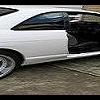Cryogenics
Announcements
-
Latest Posts
-
Sag as in the windows start to slowly open themselves, or they're just slow to go up/down with engine off?
-
It looks like it needs a big worm gear drive on it to control the rotating, not a few sloppy pins!
-
As Duncan said, first there was OBD, which few cars used, then came OBD2. Now an interesting point, OBD2 isn't even for what you want to do. OBD2 is for emissions testing. There is some sensor data on OBD2, but it's up to the manufacturer what they're putting on it. Most scan tools operate on UDS, which like OBD2 is a standard built on-top of CAN. UDS specifies how to structure a message, what very limited things mean such as "read memory address" but it does not specify what is stored in which memory address, that is all up to the manufacturer. You either a scan tool compatible with that vehicle, or to know how to reverse engineer all the data, which can take a VERY long time and a lot of vehicles to get it right. Oh and then the manufacturer does a firmware update and changes what's where... Ask me how I know that as fact Oh, and by the time you've got the scan tool that supports all the manufacturers stuff, well, you're back at "But a consult cable and the Nissan software" The main difference being most manufacturers software these days works with the same hardware readers, as the readers are built to support J2534 which is another standard for how the PC communicates with the tool to make it do specific things on the car...
-
Rotisserie is fully assembled apart from centre connector which obviously isn't required until the car is on it. It packs away fairly neatly and doesn't take up too much room. (Now that I actually have some room after my clean up!) Overall very happy with the quality of it. Assembly was a piece of piss. The only thing I didn't like was that the pins that lock the rotation lock wheels in place were a bit of a dick in a bucket scenario. It allowed the arms to rotate a significant amount even when locked in place. To fix that i measured up the hole and went and grabbed a couple of 18mm fully threaded bolts and a thread tap to suit. I ran the tap through top and bottom so it was threaded both ends. Then just threaded the bolt through both sides. It has made a massive difference which hopefully you can tell in the before and after video how much difference it made. 20250207_161431.mp4 20250207_161431.mp4 Hopefully back working on the car over the next few weeks. 20250207_162801.mp4
-
I think my main complaint with your idea is that there is a veneer of idealism spread across it. You want the simple numbers to make it easier, but all they will do is make it easier for someone to come to the wrong conclusion because the fine details will kick them in the nuts. As it is right now, the tiny bit of arithmetic is NOT the obstacle to understanding what will fit and what will not fit. The reality of trying it is what determines whether it will fit. If you had a "standard rule" that R34 GTT guards have that magic 100mm space from the hub face to whichever side you were worried about, and someone said "excellent, this wheel is only 98mm in that direction, I'll just go spend $4k on them and jam them on my sick ride".....they would just as likely find out that the "standard rule" is not true because the rear subframe is offset to one side by a fairly typical (but variable) 8mm on their car and they only have 92mm on one side and 108 on the other.
-




Recommended Posts
Create an account or sign in to comment
You need to be a member in order to leave a comment
Create an account
Sign up for a new account in our community. It's easy!
Register a new accountSign in
Already have an account? Sign in here.
Sign In Now